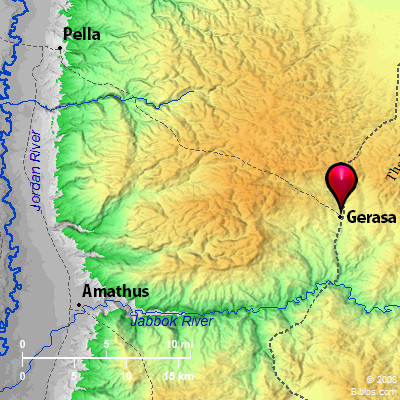Encyclopedia
GERASA; GERASENESger'-a-sa, ger'-a-senz (Gerasa; Gerasenon):
1. Country of the Gerasenes:
The town itself is not named in Scripture, and is referred to only in the expression, "country of the Gerasenes" (Mark 5:1 Luke 8:26, 37; see Westcott and Hort, The New Testament in Greek, Appendix, 11). This describes the district in which Christ met and healed the demoniac from the tombs, where also took place the destruction of the swine. It was on the eastern shore of the Sea of Galilee, and must have been a locality where the steep edges of the Bashan plateau drop close upon the brink of the lake. This condition is fulfilled only by the district immediately South of Wady Semak, North of Qal `at el-Chucn. Here the slopes descend swiftly almost into the sea, and animals, once started on the downward run, could not avoid plunging into the depths. Many ancient tombs are to be seen in the face of the hills. Gerasa itself is probably represented by the ruins of Kurseh on the South side of Wady Semak, just where it opens on the seashore. The ruins of the town are not considerable; but there are remains of a strong wall which must have surrounded the place. Traces of ancient buildings in the vicinity show that there must have been a fairly numerous population in the district.
2. History:
The great and splendid city in the Decapolis is first mentioned as taken after a siege by Alexander Janneus, 85 B.C. (BJ, I, iv, 8). Josephus names it as marking the eastern limit of Peraea (BJ, III, iii, 3). He calls the inhabitants Syrians, when, at the beginning of the Jewish revolt, the district round Gerasa was laid waste. The Syrians made reprisals, and took many prisoners. With these, however, the Gerasenes dealt mercifully, letting such as wished go free, and escorting them to the border (BJ, II, xviii, 1, 5). Lucius Annius, at the instance of Vespasian, sacked and burned the city, with much slaughter (BJ, IV, ix, 1). From this disaster it appears soon to have recovered, and the period of its greatest prosperity lay, probably, in the 2nd and 3nd centuries of our era. It became the seat of a bishopric, and one of its bishops attended the Council of Chalcedon. Reland (Pal, II, 806) notes certain extant coins of Gerasa, from which it is clear that in the 2nd century it was a center of the worship of Artemis. It was besieged by Baldwin II, in 1121 A.D. Mention is made of the strength of the site and the mighty masonry of its walls. William of Tyre calls the city Jarras, and places it 16 miles East of Jordan (Hist, xii, 16). The distance is about 19 miles from the river. It was conquered by the Moslems in the time of Omar (Guy le Strange, Palestine under the Moslems, 462). The sultan of Damascus is said to have fortified it; but there is nothing to show that the Moslems occupied it for any length of time.
3. Description:
Modern Jerash lies on both banks of Wady Jerash, about 6 miles from its confluence with Wady ez-Zerqa (the Jabbok). It is almost 20 miles from Amman (Philadelphia), and 22 from Fahil (Pella). The ruins are wide and imposing and are better preserved than any others on the East of Jordan. They include several splendid temples, theaters, basilica, palaces and baths, with hippodrome and naumachia. The triumphal arch to the South of the city is almost entire. Two paved streets with double colonnades cut through the city at right angles, four massive pedestals still marking the point of intersection. An excellent account of the ruins is given in Thomson's LB, III, 558.
There is nothing above ground of older date than the 2nd and 3rd centuries of our era; but there is no reason to doubt that the Greek city of Gerasa stood on the same site. The presence of a copious spring of sweet water makes it probable that the site has been occupied from olden time; but no trace remains of any ancient city. Some would identify the place with RAMOTH-GILEAD, which see.
The site is now occupied by a colony of Circassians, and there is reason to fear that, unless something is done to preserve them, many valuable remains of antiquity will perish.
W. Ewing
GER'GESA and Gergesenes, perhaps same as Gadarenes.




